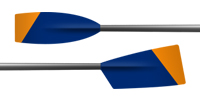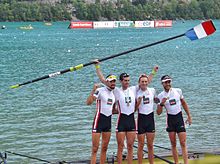Strap (shipping)

The belt is the concept of Seemannssprache a rudder for propulsion of a rowing boat or rowing vessel , which is moved by rower with both hands. The somewhat smaller oars, which are handled in pairs by the oarsman at the same time, are called skulls in the sailor's language . Both types of oars have in common that they are movably connected to the ship's side so that the hands of the oarsman move in the direction of travel as long as the blade is in the water.
This reflects both types differ from rudders (and likewise the helm ) from the paddle , which has no connection to the boat hull, and in which the paddler or Kanut moves further away from the retained into the water Journal hand in the direction of travel, the hand nearer to the sheet but backwards .
The rowing technique practiced with oars is simply referred to as "oar rowing". By moving the sling rod in the shape of a parallelogram, the rower lowers the blade into the water, pulls it against the direction of travel and thus propels the float. Then he leads the belt back to its starting position over water.
Apart from rowing , oars are also used to propel rowing boats, the largest of which are the galleys . Modern rowing only emerged later on the basis of this technology, which for a long time was the only way to move about on the water independently of the wind. When sculling , a special form of rowing, only one belt is used with a special technique for locomotion per boat.
construction
The core component of a belt is called the shaft . At the inner end is the approx. 30 cm long handle on which the rower holds and guides the strap with both hands. Handles made of rubber or wood are widely used. Almost a third of the length of the shaft is a cuff that encloses the shaft. The clamping ring is attached to the cuff, which divides the belt into the inner lever (part up to the end of the handle) and the outer lever (part up to the end of the rudder blade). The position of the clamping ring can be adjusted by a few centimeters along the shaft and thus change the transmission ratio of the belt (length ratio of inner lever to outer lever).
At the outer end of the belt is the rudder blade , which is built and used in various forms. The symmetrical “Macon blade” is mainly used today in rowing training and in leisure and touring rowing . It is named after the French city of Mâcon , because at the European Rowing Championships in 1959 in this place it was successfully used and quickly replaced older blade shapes. Various asymmetrical blade shapes are referred to as “big blades”, which are particularly important in racing rowing and have only been manufactured since around 1985.
Straps for the starboard and port sides are basically constructed the same, but they are slightly asymmetrical to one another and are not interchangeable. The reason for this is that the rudder blade is slightly tilted in the upright position (“contact angle”), which is achieved, among other things, by the structural properties of the oars. Reversing the straps on the side of the boat therefore results in a configuration that is hardly rowable.
From a physical point of view, a belt or scull is a lever in which the power arm is shorter than the load arm, so that a relatively short movement of the rower, but greater use of force, results in a longer and therefore faster movement of the rudder blade and thus of the boat.
Materials
Traditionally, straps were made of wood. The shaft and blade were made of spruce , the cross-band to protect the blade and the contact wedge were made of ash . Since the 19th century, the wooden belts were built hollow on the inside to reduce the overall weight. Wooden straps are very easy to repair in the event of damage.
Since the mid-1980s, carbon fiber reinforced plastic (CFRP) has become increasingly popular as the material for the shaft. CFRP belts are lighter and more rigid and torsion- resistant than wooden belts. Thanks to the various arrangements of carbon fibers, the rigidity of the belts can meanwhile be precisely adapted to different usage scenarios. In racing rowing, oars that are as stiff as possible are used, while in touring rowing, a certain amount of bending when the oar is turned is desirable. Damage to a plastic shaft usually means total loss.
Since the CFRP skulls and straps have prevailed since the 1990s, the wooden versions are rarely manufactured today. Since both versions are very durable with good care, old wooden oars are often still used in recreational sports.
Dimensions
Straps are generally larger and heavier than sculls . The exact dimensions depend on the specific purpose, the level of performance of the rowers and the design:
- Strap with Macon leaf: length approx. 380–384 cm
- Strap with big blade: length approx. 370–377 cm
In many cases, straps can also be adjusted in length by a few centimeters.
The weight depends largely on the material of the shaft. A wooden belt weighs around 4 kg, a modern CFRP belt just a little over 2 kg.
use
When used in rowing, the oarlock is inserted into a oarlock that is connected to the rowing boat via the boom . The cuff protects and supports the shaft of the oarlock, and the clamping ring, which is located inside the oarlock as seen from the rower, determines the position of the shaft in the oarlock. If the belt is inserted correctly, the handle extends over the rowing area approximately to the opposite side of the rowing boat. The athlete grabs the handle with both hands at about shoulder width. The outer hand ("outer hand") is positioned at the extreme end of the handle, while the "inner hand" lies further inside. In rowing, straps are mainly guided and controlled with the palm of the hand, while the external hand is mainly used for power transmission because of the better lever.
In contrast to "sculling", every rower only uses one oar with both hands when oaring. Oars and their rudder blades are larger than sculls, but the total area of both sculls is larger than that of one oar. The scull rower therefore has to cope with a higher pressure than the oar rower.
For reasons of simplicity, the oarlock was mostly dispensed with, especially in shipping and on historic rowing ships. The belt was then rotatably mounted on the ship's side.
language
The word "belt" comes from the Middle High German belt and the Old High German riemo from the Latin remus ( oar belt ).
Oars and sculls are often referred to as “rudders” by laypeople in particular, although this term now refers to rudders . The somewhat confusing use of language stems from the fact that the conceptual distinction between “oars” and “oars” is relatively recent. Originally the “ rudder ”, also called gubernaculum (“guide device ”) or clavus (“nail”) in Latin, was simply a particularly large strap attached to the stern or elsewhere on the ship's wall and the other “straps” used for locomotion “(Latin remus ), which in principle had the same shape as the rudder used for steering, were not linguistically differentiated. For this reason, “rudder” can still be understood as a collective term for rudder and locomotion rudder (belt) without any problems. Among seafarers and water sports enthusiasts, however, it is frowned upon to refer to oars as oars, since this type of expression is considered to be amateurish and the speaker thus identifies himself as a " landlubber ".
market
Skulls and straps from various manufacturers are available on the market. The companies Concept2 , Croker Oars, Dreher, Brača-Sport and the Empacher shipyard have a broad market share . Historically, the boatyards in particular were involved in the manufacture of wooden belts, such as the former Karlisch Werft. The price for a pair of belts depends on the design and the manufacturer and is typically between 400 and 800 euros.
Belt boat classes
Since the forces of two rowers complement each other in a belt boat, an even number of rowers is always necessary in these classes. The designation of belt boats is similar to the generic terms two , four and eight , which are also generally used as a designation for a rowing boat with two, four or eight athletes. Since there are versions with and without a helmsman for two and four , this characteristic is also part of the designation of belt boat classes. On the other hand, scull boats are delimited with the prefix “double”. Important belt classes are:
- Two without a helmsman
- Two with a helmsman
- Foursome without a helmsman
- Foursome with a helmsman
- Eighth (always with helmsman)
literature
- Wolfgang Fritsch: manual for rowing . 4th, revised edition. Meyer & Meyer Verlag, Aachen 2006, ISBN 978-3-89899-111-7 , p. 39, 50 .
- Volker Nolte: Using Equipment More Effectively . In: Volker Nolte (Ed.): Rowing Faster . 2nd, expanded edition. Human Kinetics, Champaign 2011, ISBN 978-0-7360-9040-7 , pp. 125-143 (English).
Web links
- Historical development of sculls and straps ( Memento from August 25, 2016 in the Internet Archive )
- Trimming of boats with typical dimensions of sculls and oars on the website of the Rowing Association Schleswig-Holstein
Individual evidence
- ↑ Duden: "Belt, the". Duden , accessed on November 28, 2014 .


